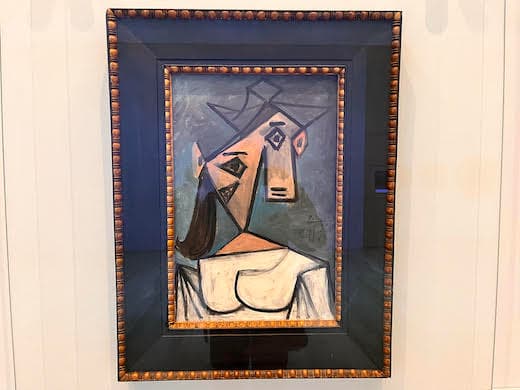Greece’s Little Picasso Problem Is Now a Kind of Triumph
The big news is that ‘Woman’s Head’ is even on public display, because for a decade and until quite recently it was in a thief’s grasp.

ATHENS — “Is Dora Maar around here somewhere?” I asked a security guard standing two floors beneath the glassy entrance atrium of the new National Gallery at Athens. When I saw the faint outline of a grin break out from behind the guard’s mask and heard the lightly accented reply, “Sir, she is right behind you,” I was both mortified and thrilled.
My first impression of Dora Maar came not from a museum but a big screen, thanks to her depiction in Alan Rudolph’s mostly forgotten film “The Moderns.” The 1988 movie was a sumptuous aperçu of 1926 Paris, and the vision of Pablo Picasso’s famed flame and muse acting like a boss in a smoky, if imagined, Left Bank café fired up in me an irrational passion for Paris. That eventually burned itself out, but it’s funny how in a split second a single, small painting can bring everything back.
Of course, the big news is that “Woman’s Head” is even on public display. Picasso created the painting, which I will not attempt to describe, in 1937 — the same year he painted “Portrait of Dora Maar.” That oil on canvas is one of the artist’s masterpieces and has a comfortable home at the Musée Picasso, but this smaller rendition has had a more adventurous journey in part because for a decade and until quite recently it was in a thief’s grasp.
In January 2012, a Greek construction worker stole “Woman’s Head” and a Mondrian painting from Greece’s former National Gallery. That the burglar did the deed with astonishing ease — reportedly in under seven minutes — was actually less of a scandal than the unfortunate fact he was Greek.
That is because Picasso donated the Cubist painting to Greece in 1949 to honor the country’s resistance to Nazi rule. The back of the canvas is inscribed with the words, “for the Greek people, a tribute.”
In 2021 Greek police finally tracked down both the thief and his quarry. Yet the drama did not end with the retrieval of the canvas, which the self-described Picasso enthusiast had wrapped in protective materials before hiding it outdoors, in a gorge south of Athens.
As the police were preparing to present “Woman’s Head” to reporters at a press conference, an officer adjusting the artwork on a shelf momentarily lost his grip, and the still-unframed painting slid unceremoniously onto the floor. The Greek muses must have been watching, because the painting was not damaged in the fall. That did not stop the Greek public and a comedian from having a field day with the episode.
Greece’s new National Gallery opened on March 24, 2001, not far from the American Embassy and just a day before the bicentennial of the Greek Revolution. “Woman’s Head” finally went on display late in October.
It did so without much fanfare, which is surprising for a painting that could probably command millions of dollars at auction, though it never will.
At that emotionally charged press conference the year prior, Greece’s culture minister, Lina Mendoni, told reporters, “This painting is of particular importance and sentimental value … as it was personally dedicated by the great painter to the Greek people for their fight against fascist and Nazi forces. It would have been impossible to sell.”
Now it is at home on a somewhat lonely level in the museum’s new Western European art wing. During my visit, I could not help but notice the painting’s proximity to a tableau by Eugène Delacroix titled, “Episode from the Greek War of Independence.”
The artist painted it in 1856, a year when the tribulations of the Greeks’ struggle for independence still loomed heavily in the drawing rooms and artists’ studios at Paris. With characteristic flamboyance, Delacroix depicts the hoof of a fierce-looking Greek fighter’s horse about to stomp on the shoulder of a slain Turk.
It’s no obvious vision of beauty, but a reminder that civilizational clashes are part of the European tapestry. It is heavy stuff when one pauses to reflect on it, though it seems few people do. I’m probably not the only one who would rather have a date with Dora.

